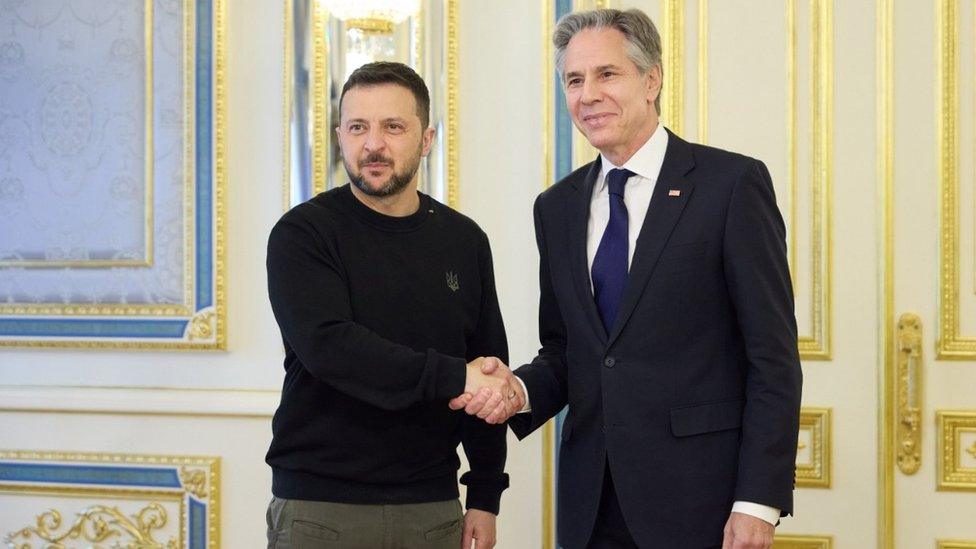Key weeks ahead for Russia’s war in Ukraine
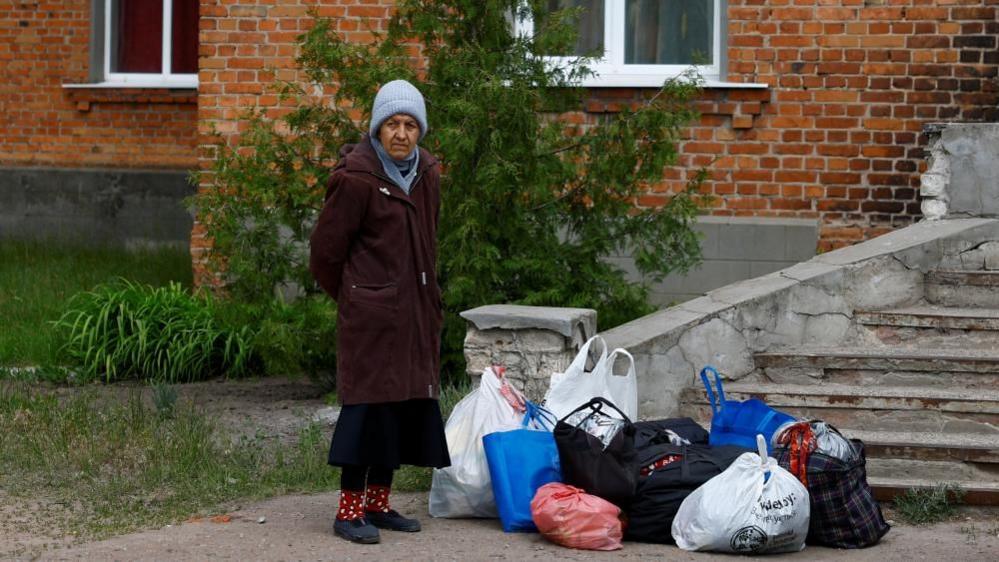
Vovchansk's remaining population was evacuated as Russia shelled the border town
- Published
Ukraine knew Russia was planning a summer offensive, but not where it would start. That became clear on 10 May, as Russian forces penetrated the border area near Kharkiv, Ukraine’s second largest city.
They have since grabbed a number of villages on Ukraine's northeastern frontier, and are trying to push forward as Ukraine’s outgunned forces try to shore up a weakened front line.
A buffer zone or a deeper push?
By entering Vovchansk, only 5km (3 miles) inside Ukraine, and seizing large areas of Ukrainian territory in the Kharkiv region, Russian forces may be trying to create a buffer zone to fend off Ukraine’s own cross-border attacks.
Having seen the relatively poor state of Ukraine’s defences, they may also have far more ambitious plans.
Russia’s Vladimir Putin has for some time talked of setting up some kind of “sanitary zone” that would protect the southern Belgorod region from drone or missile attack. Belgorod has also proved vulnerable to cross-border incursions by two Ukraine-based Russian paramilitaries.
Russia could be planning a further cross-border push towards the northern city of Sumy, to the north-west. Ukraine’s military spy chief, Kyrylo Budanov, believes a “small group of forces” is waiting there, ready to act.
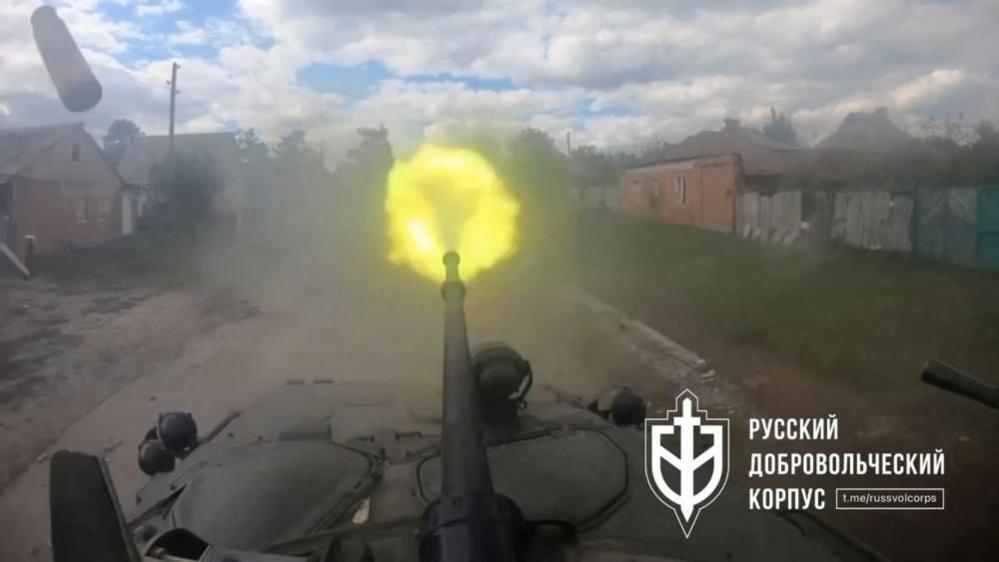
The fight for control of Vovchansk in recent days has been intense
Sergei Shoigu, the new head of Russia’s security council, has said only that the military is advancing in all directions.
That could involve pushing deeper into Ukraine, either to force Kyiv to divert forces from the fiercest front line in the eastern Donbas or seize increasing amounts of territory.
The US-based Institute for the Study of War think tank believes the main aim is to create a buffer zone, as does Russian military analyst Anatoly Matviychuk.
But Russian forces are also pushing towards the village of Lyptsi, some 20km from the northern outskirts of Kharkiv and, in his words, “we can practically see the suburbs of Kharkiv through binoculars”. Suddenly capturing Ukraine’s second biggest city could be in Russian sights.
Ukraine's defence lines stretched as Russian troops advance
- Published17 May 2024
The Russians simply walked in, Ukrainian troops in Kharkiv tell BBC
- Published13 May 2024
Is Kharkiv at risk?
With a pre-war population of 1.4 million, Kharkiv comes behind only Kyiv and Dnipro in its economic importance to Ukraine. It is too close to the border to have sufficient air defence and has repeatedly come under lethal Russian bombardment from ballistic and remodelled anti-aircraft missiles and glide bombs.
If Russia could capture it, Matviychuk says it would prove a “turning point” in the war and hit Ukraine’s industrial potential hard.
That seems highly unlikely. Ukrainian and Western commentators are convinced Russia does not have the resources to do so. If it took 80,000 Russian troops to capture the devastated eastern city of Avdiivka last February, a much bigger city like Kharkiv would require numbers that Russia does not have.
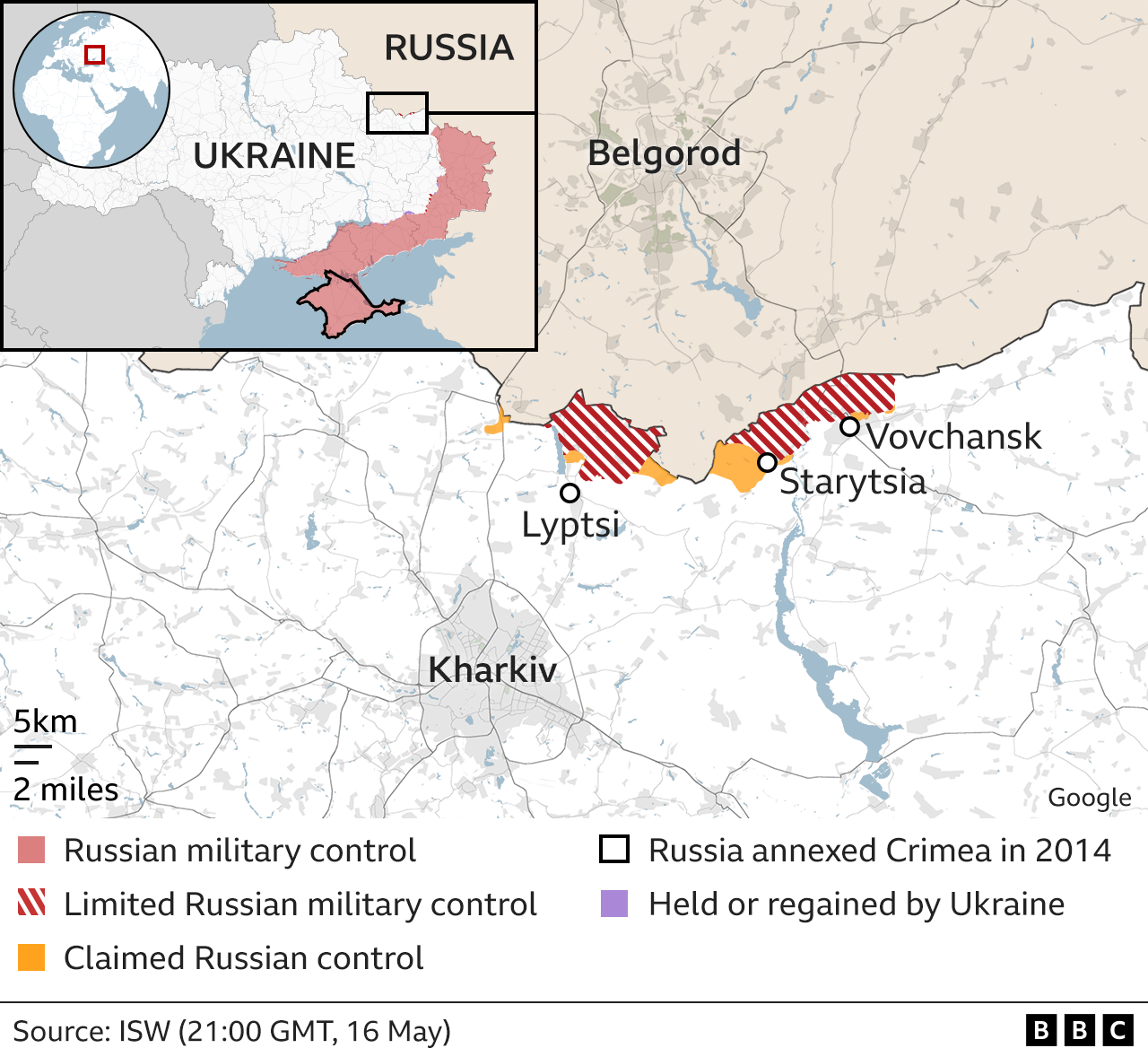
Vladimir Putin has said "there are no such plans as of today" for Russia to capture the city, although he has not always been truthful about his ambitions in Ukraine.
President Volodymyr Zelensky, on a visit to Kharkiv, said the situation in the region was “generally under control”, although the area remained extremely difficult.
“The strategic intention of the Russian troops is… the encirclement of Kharkiv as a regional centre,” says Oleksandr Musiienko, head of the Centre for Military and Political Studies in Kyiv.
That way, they would not only create a buffer zone of 10-15km in depth, he says, but also give Russia the option of attacking Kharkiv later.
Ukrainian military blogger Yuriy Butusov says too many mistakes were made in defending the border and, now that Russian forces have seen how thinly spread the defences are, they could try to set up both a buffer zone and a bridgehead, to launch deeper into Ukrainian territory: “Of course, this is their goal.”
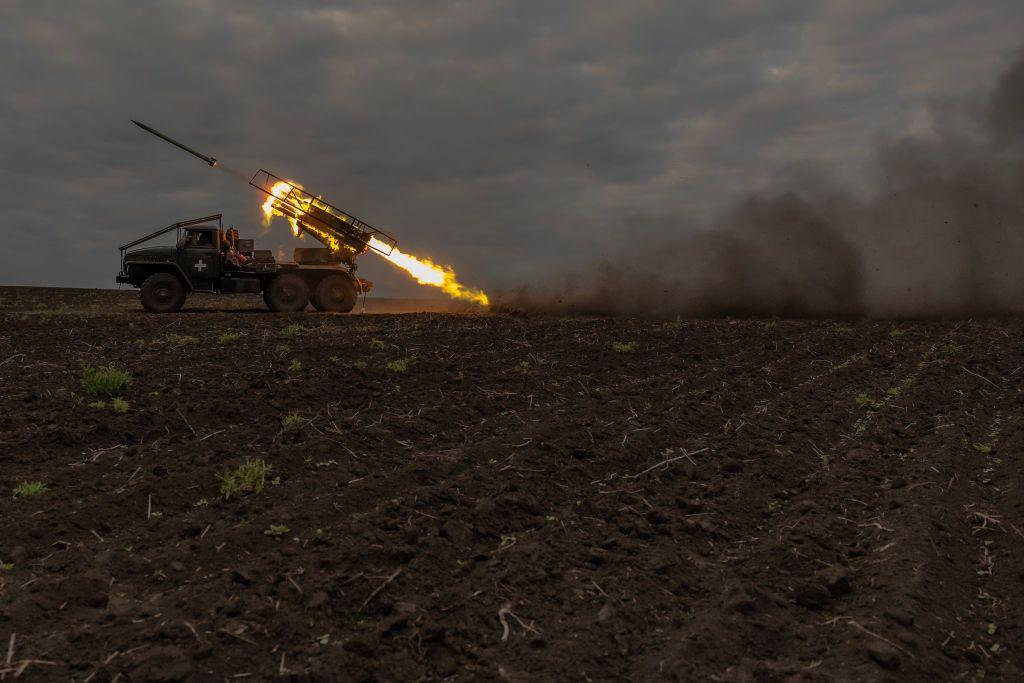
Ukraine's military has sent more troops to Kharkiv to hold back Russia's advance
Russia's focus on the east
For many months the war has dragged on with Russian forces securing minor gains at great human cost, especially in the eastern region of Donetsk.
Jack Watling of the Royal United Services Institute believes the main aim of the summer offensive is “the expansion of the Russian push in Donbas”, with the aim of cutting supply lines and then giving their forces a route to both north and south.
When Russia launched its full-scale invasion in February 2022, its declared goal was to seize the entire Donbas region, made up of Donetsk and Luhansk.
Three months on from the capture of Avdiivka, the Russian military has set its sights on other targets northwest of the city, including the strategically important hilltop town of Chasiv Yar.
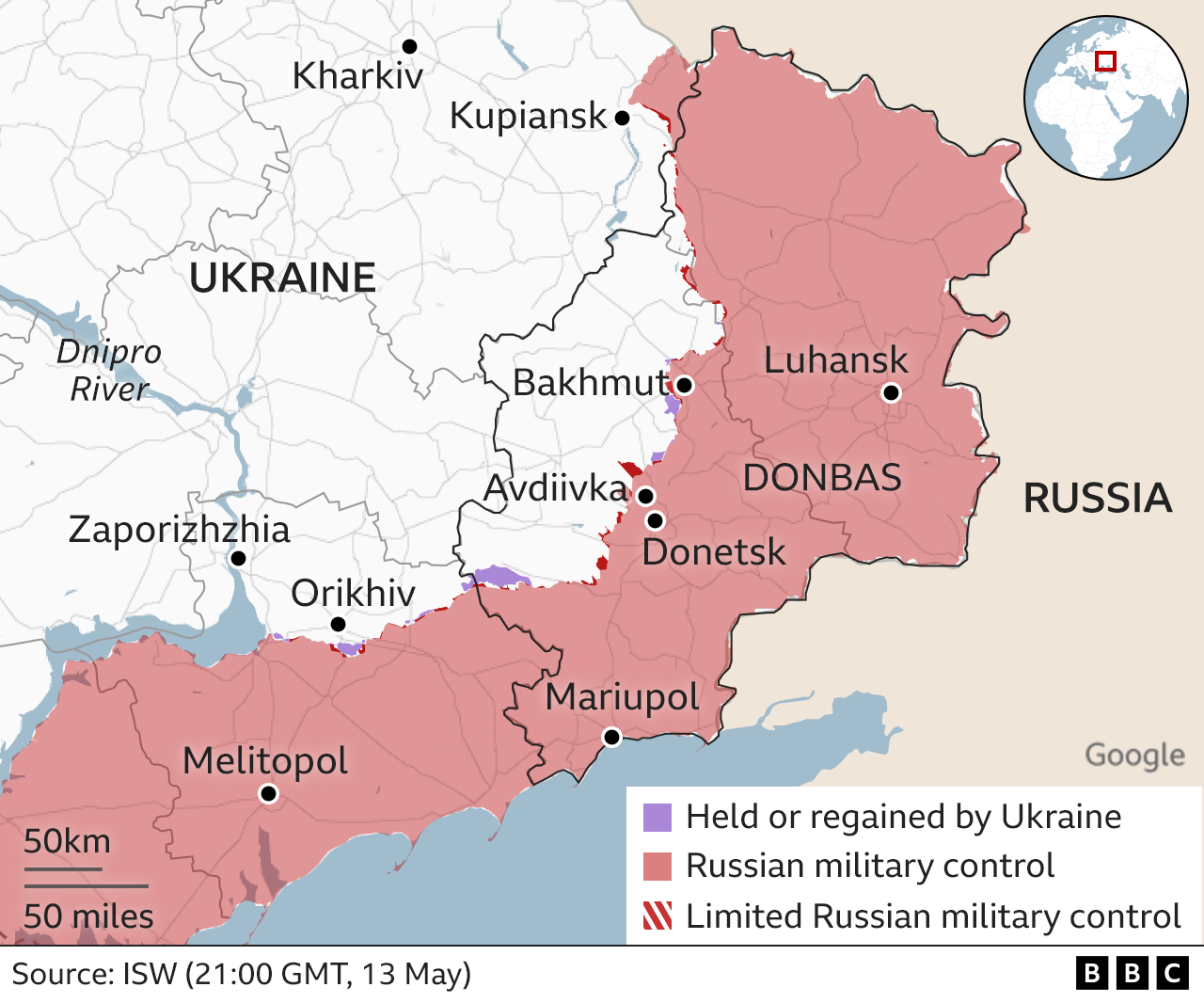
Rob Lee of the Foreign Policy Research Institute says Ukrainian troops who were based in Chasiv Yar are thought to have been moved to Kharkiv, leaving Ukraine with fewer units available there.
Losing Chasiv Yar would make Ukrainian cities in Donbas even more vulnerable to Russian attack.
By forcing Ukraine to commit troops, air defences and artillery to the defence of its second city, pressure would also be put on the frontline further south, near the Dnipro river and then threatening the big south-eastern city of Zaporizhizia.
Russian forces have already claimed the capture of one southern village that Ukraine recaptured last summer. Even if Ukraine is still in control of that village of Robotyne, it is clear that Russia’s offensive in the north places considerable pressure on Ukraine’s outnumbered forces elsewhere.
Does Russia have enough resources to gain ground?
In Kyiv, they believe Russia’s force in Ukraine now numbers more than half a million. That has left Ukraine’s military outmanned as well as outgunned, with Vladimir Putin now devoting an estimated 8.7% of Russia’s entire economic output (GDP) to defence and security.
But the reinforcements waiting over the northern border number only a reported 20,000, and for all the reports of Kremlin plans to mobilise 300,000 more Russians, there is no evidence of anything like that.
Although Ukraine's total military force is about 800,000, Russia has a big numerical advantage in the major combat zones. A senior Ukrainian general said in places the ratio was as high as 10 to one. A similar advantage is reported in terms of shells.
Ukraine recently signed into law an act lowering the age of mobilisation by two years to 25, and that could increase the size of its military by a reported 100,000.
But that change will take time. As will the arrival of US arms supplies as part of a $61bn (£48bn) aid package voted through by the US Congress in April.
Nato’s Supreme Allied Commander Europe, Gen Christopher Cavoli, has said he is confident Ukraine’s military can hold the line: "The Russians don't have the numbers necessary to do a strategic breakthrough... more to the point, they don't have the skill and the ability to do it.”
And the man appointed Ukraine’s commander-in-chief in February, Oleksandr Syrskyi, is considered the architect of Ukraine’s fightback in September 2022, when the army pushed Russian units out of more than 500 places in Donbas and the Kharkiv regions. One of the villages they liberated was Vovchansk.
The difference now is that Russia’s commanders will have learned from their mistakes.
"The city of Kharkiv and the entire Kharkiv region is now the point of our efforts to make the lives of Kharkiv residents safer,” Ukraine’s Foreign Minister Dmytro Kuleba said this week.
What Putin wants
While Russia’s leader pursues gains on the ground, there have been signs that the Kremlin could be prepared to return to peace talks abandoned two years ago.
“We are open to a dialogue on Ukraine, but such negotiations must take into account the interests of all countries involved in the conflict, including ours,” Vladimir Putin told China’s state news agency Xinhua.
The timing of his remarks come a month before a peace summit in Switzerland, organised at President Zelensky's request.
Russia has not been invited to Lucerne on 15-16 June, but the Swiss say more than 50 countries including Ukraine are going, and they are trying to get Russia’s ally China involved.
Related topics
- Published16 May 2024
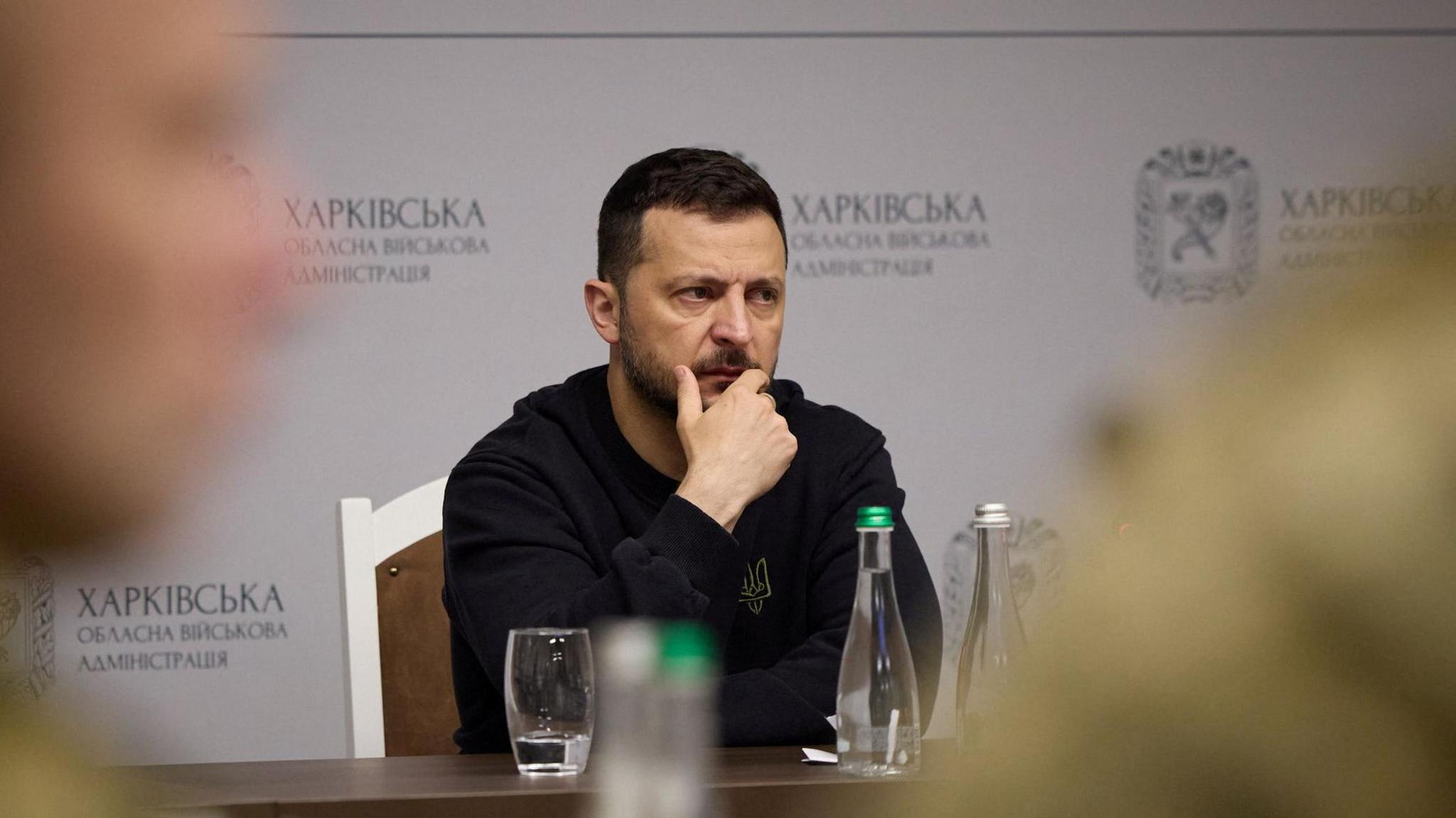
- Published17 February
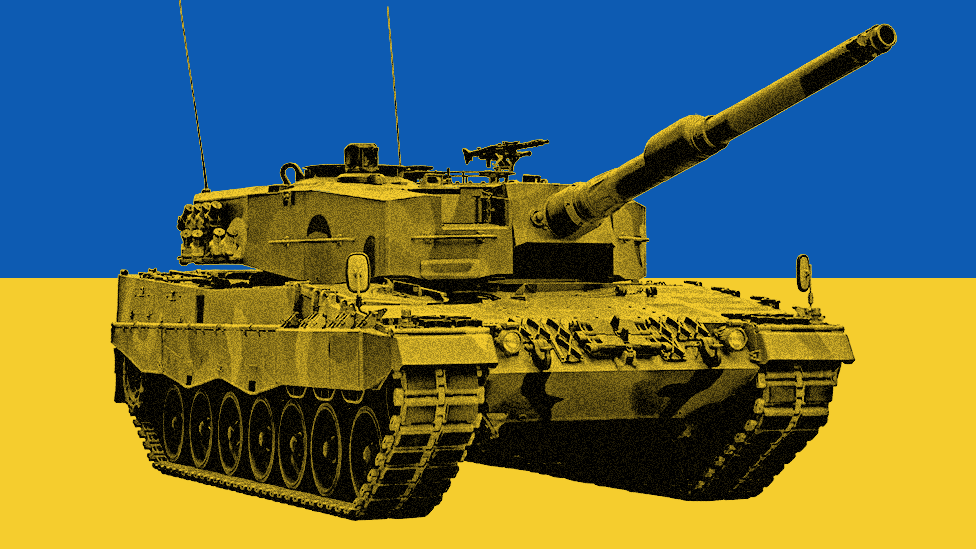
- Published14 May 2024
